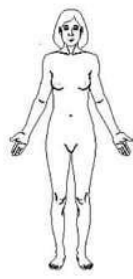Anatomical Positions
1/25
Earn XP
Description and Tags
AB
Name | Mastery | Learn | Test | Matching | Spaced |
|---|
No study sessions yet.
26 Terms
Anatomy
the study of structures and the relationships among structures
Physiology
the study of how body structures function
Anatomical position
body is erect with the feet parallel and the arms hanging at the sides with palms facing forward
Anterior
to be situated near or toward the front of the body

Posterior
to be situated toward the back of the body

Superior
to be situated towards the upper part or head of the body, positioned above another organ or stucture
Inferior
to be situated toward the lower part of the body or positioned below another organ or structure
Cranial
refers to the head end
Caudal
refers to the tail end
Medial
to be closer to the midline of the body or a structure, internal, toward the midline
Lateral
to be farther away, in the direction of either side, away from the midline
Proximal
toward or nearest the trunk or the point of origin of a part
Distal
away from or farthest from the trunk or the point of origin of a part
Unilateral
on one side
Bilateral
on both sides
Superficial
near the outer surface of the body
- skin is superficial to the muscle layer
Intermediate
between two other structures
- the naval is intermediate to the left arm and the contralateral(right) leg
Deep
further away from the surface of the body
- the muscle layer is deep to the skin but superficial to the intestines
Body planes
based on four imaginary planes that pass through the body in anatomical position
Sagittal plane (Anteroposterior)
divides the body into right and left parts
Midsagittal/median
divides the body into two equal halves
Frontal/coronal plane
divides the body into anterior and posterior parts
Medial (Internal) Rotation
Anterior surface moves toward midline
Lateral (External) Rotation
Anterior surface moves away from midline
Protraction(Abduction)
Moving forward on plane parallel to ground “punch”
Retraction(Adduction)
Moving backward on plane parallel to ground “start lawn mower”